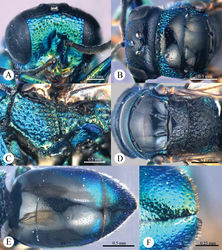Omalus
| Notice: | This page is derived from the original publication listed below, whose author(s) should always be credited. Further contributors may edit and improve the content of this page and, consequently, need to be credited as well (see page history). Any assessment of factual correctness requires a careful review of the original article as well as of subsequent contributions.
If you are uncertain whether your planned contribution is correct or not, we suggest that you use the associated discussion page instead of editing the page directly. This page should be cited as follows (rationale):
Citation formats to copy and paste
BibTeX: @article{Wei2014ZooKeys407, RIS/ Endnote: TY - JOUR Wikipedia/ Citizendium: <ref name="Wei2014ZooKeys407">{{Citation See also the citation download page at the journal. |
Name
Omalus Panzer, 1801 – Wikispecies link – Pensoft Profile
- Omalus Panzer, 1801: 13. Type species: Chrysis aenea Fabricius, 1787. Bohart and Campos 1960[1]: 235 (partim, Omalus s. s.); Bohart and Kimsey 1982[2]: 36 (partim, Omalus s. s.); Kimsey and Bohart 1991[3]: 243; Rosa 2005[4]: 8; 2006[5]: 100.
Diagnosis
This genus is close to Holophris Mocsary, 1890, Philoctetes Abeille, 1879, and Pseudomalus Ashmead, 1902, but can be distinguish by mesoscutum impunctate and transpleural carina reaching the apex of propodeal angle. Other diagnostic characteristics are: scapal basin deep, smooth and glabrous, rarely with weak striae; malar space equal to or longer than 1 MOD, rarely less than 1 MOD, and horizontally bisected by the genal carina; mandibles tridentate; pronotum impunctate medially or nearly so; mesopleuron with scrobal sulcus horizontally, and with a single carina dorsally; transpleural carina reaching the apex of propodeal angle; scutellum with two flattened foveae on anterior margin; metanotum round or hemispherical; tarsal claw with three to six teeth; apex of T-III usually with small medial notch, rarely absent.
Biology
Species of Omalus have been reported as parasitoids of some crabronid wasps (Mocsáry 1889[6]; Tsuneki 1952[7]; Krombein 1963[8], 1967[9]; Parker and Bohart 1966[10]; Nozaka 1969[11]; Bohart and Kimsey 1982[2]; Tormos et al. 1996[12]; Rosa 2006[5]).
Distribution
Omalus occurs in all zoogeographic regions, except Australia. There are 26 valid Omalus species, of which 19 are found in the Palaearctic, one in both the Holarctic and the Oriental, three in the Nearctic, two in the Afrotropical, and one in the Neotropical Regions.
Key to the Chinese species of the genus Omalus Panzer
Taxon Treatment
- Wei, N; Rosa, P; Liu, J; Xu, Z; 2014: The genus Omalus Panzer, 1801 (Hymenoptera, Chrysididae) from China, with descriptions of four new species ZooKeys, 407: 29-54. doi
Other References
- ↑ Bohart R, Campos L (1960) A review of the genus Omalus Panzer in North America (Hymenoptera, Chrysididae). Annals of the Entomological Society of America 53(2): 235-250.
- ↑ 2.0 2.1 Bohart R, Kimsey L (1982) A synopsis of the Chrysididae in America north of Mexico. Memoirs of the American Entomological Institute 33: 1-166.
- ↑ Kimsey L, Bohart R (1991) The Chrysidid Wasp of the World. Oxford University Press, New York, 652 pp.
- ↑ Rosa P (2005) I Crisidi (Hymenoptera, Chrysididae) del Museo Civico di Storia Naturale di Milano. Natura, Milano, 128 pp.
- ↑ 5.0 5.1 Rosa P (2006) I Crisidi della Valle d’Aosta. Monografie del Museo regionale di Scienze naturali, St.-Pierre, Aosta, 368 pp.
- ↑ Mocsáry A (1889) Monographia Chrysididarum Orbis Terrarum Universi. Hungarian Academy of Science, Budapest, 643 pp.
- ↑ Tsuneki K (1952) Ethological studies on the Japanese species of Pemphredon (Hymenoptera, Sphecidae), with notes on their parasites, Ellampus spp. (Hym., Chrysididae). Journal of the Faculty of Science, Hokkaido University 11: 57-75.
- ↑ Krombein K (1963) The host-parasite relationship of Xylocelia virginiana Rohwer and Omalus intermedius (Aaron). Proceedings of the Entomological Society of Washington 63(4): 264.
- ↑ Krombein K (1967) Trap-nesting wasps and bees. Smithsonian Press, Washington, 570 pp.
- ↑ Parker F, Bohart R (1966) Host-parasite association in some twig-nesting Hymenoptera from western North America. Pan-Pacific Entomogy 42: 91-98.
- ↑ Nozaka C (1969) Omalus punctata (Uchida) (Hym., Chrysididae) parasitic on Pemphredon diervillae Iwata (Hym., Sphecidae). Life Study (Fukui) 13: 65-66.
- ↑ Tormos J, Asis J, Gayubo S, Mingo E (1996) Description of the mature larvae of Chrysis gracillima and Omalus biaccinctus and new data on the biology of Trichrysis cyanea (Hymenoptera: Chrysididae). Florida Entomologist 79(1): 56-63. doi: 10.2307/3495754
Images
|







